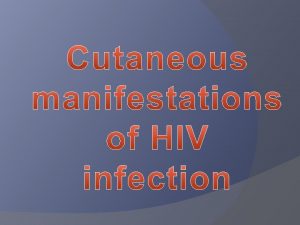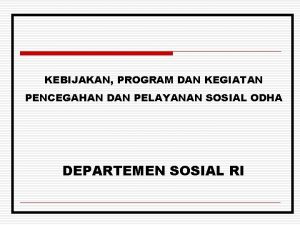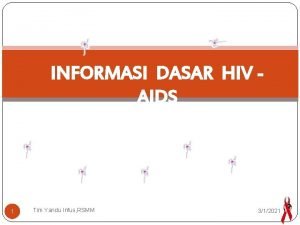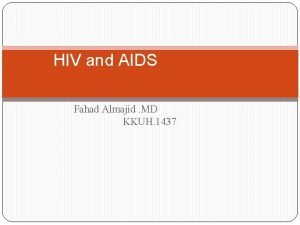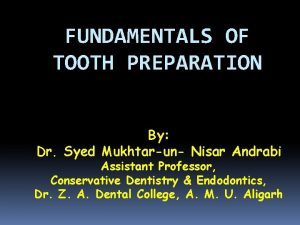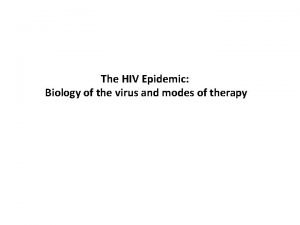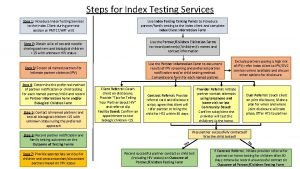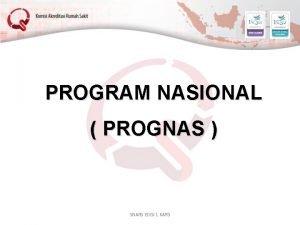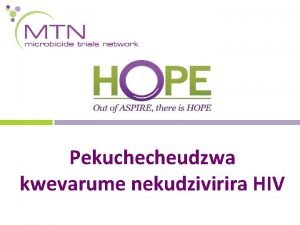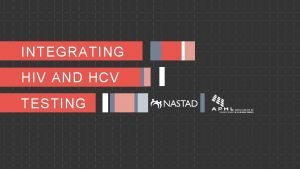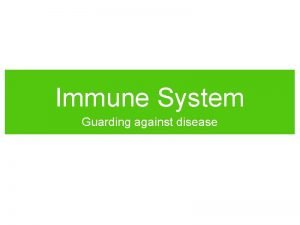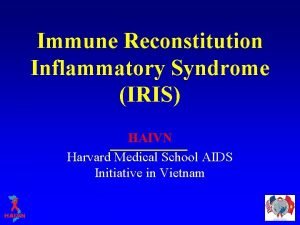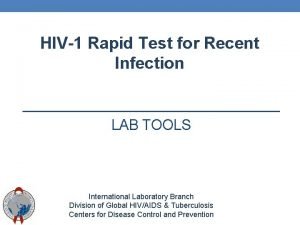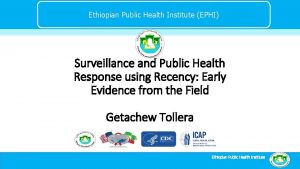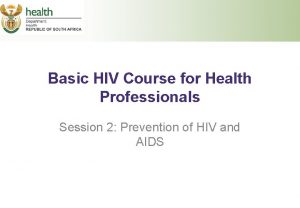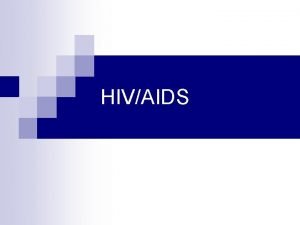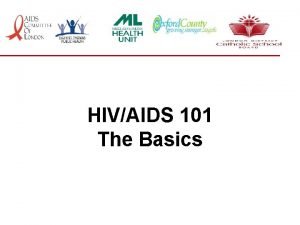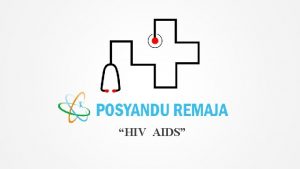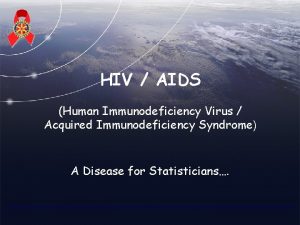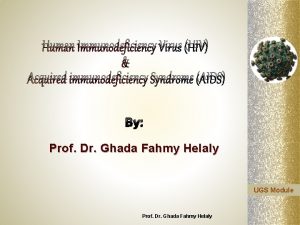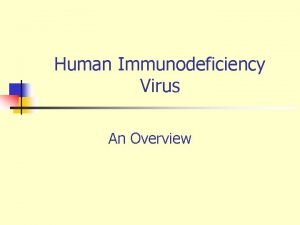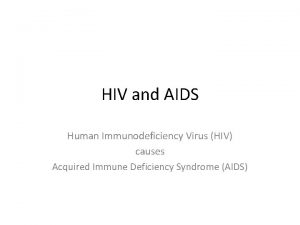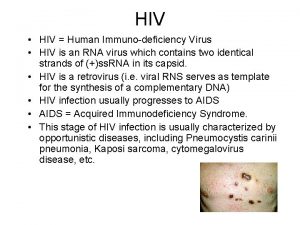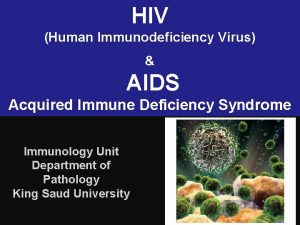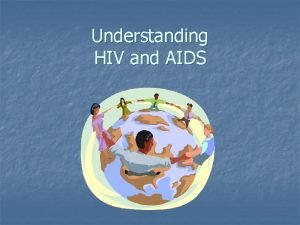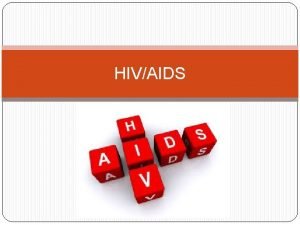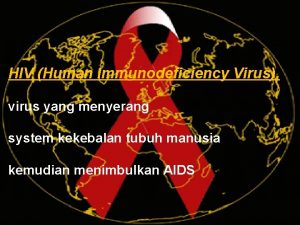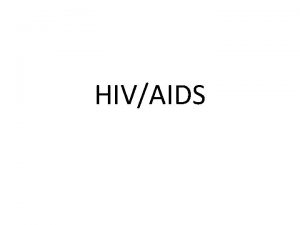Human Immunodeficiency Virus HIV AIDS final stage of









































- Slides: 41

Human Immunodeficiency Virus (HIV), AIDS (final stage of HIV infection) and RSAT Andrew Klein, Ph. D. Advocates for Human Potential, Inc.

Housekeeping: Functions 9/16/2020 2

Housekeeping: Communication 9/16/2020 3

Human Immunodeficiency Virus (HIV), AIDS (final stage of HIV infection) and RSAT Moderator Stephen Keller Training/TA Coordinator, RSAT-TTA March 15, 2017 4

Andrew Klein, Ph. D. aklein@ahpnet. com Advocates for Human Potential www. ahpnet. com 9/16/2020 5

Objectives Participants will be able to: • Develop increased awareness of relationship between HIV infection and substance use in correctional settings • Define strategies for delivery of specialized care coordination for infected individuals enrolled in RSAT programs • Understand preventing HIV infections or transmission among RSAT clients both inside and outside correctional institutions 9/16/2020 6

Why HIV/AIDS an important issue for RSAT? The rate of HIV among prisoners is 5 to 7 times that of the general population (2017). In 2015, there were 17, 140 incarcerated in state prisons with HIV, infecting 2. 6% of women and 1. 8% of males imprisoned. Among jail populations, African American males 5 times as likely as Caucasian and twice as likely as Hispanic males to be infected. African American women twice as likely to be infected as others (2017) Most people who enter prison/jail are already infected with HIV, a much smaller number contract it in prison/jail (CDC, 2006) 7

Why Important for RSAT? Substance abuse negatively impacts HIV/AIDS outcomes and multiplies a person’s risk for HIV infection nearly 12 times (CSAT, 2000). The adverse impact of untreated substance use disorders on the criminal justice system and the prevalence of HIV among incarcerated populations make it critical to integrate knowledge about HIV detection and prevention into RSAT programs. RSAT staff in ideal position to respond to both epidemics, coordinating substance use & mental health treatment, medical care, case management, and support as well as transitional planning and reentry referrals. 8

First Step, Diagnosis Challenge in prison/jail HIV testing A 2010 Study of NYC jails found 28% of individuals with HIV had not been diagnosed at the time of their admission to jail. Further, despite a four-fold increase in jail testing, many still not identified through routine voluntary testing, because many opt out of testing. 9

HIV Testing Hurdles Concerns about privacy and stigma must be overcome Fear of disclosure of high-risk sexual behaviors (Assume fear of disclosure of injection drug use will not apply to RSAT populations!) The assumption of homosexuality (founded or unfounded) can put a male inmate at risk for physical assault, gang rape, sexual slavery and HIV infection from forced or coerced unprotected sex (PREA, 2009). Need to assure of safeguards of information, confidentiality, as much as possible (The security demands of the environment tend to compromise confidentiality and privacy. In small jails and high security prisons maintaining medical confidentiality can be a logistical impossibility. ) Note: In 2004, Mississippi and Alabama’s practices of discriminatory segregation of HIV positive inmates were disallowed (Sylla, 2008). However, clustering those with AIDS for efficiency of treatment as in California allowed. 10

HIV Testing in Prisons In 2015, 34% of those entering prisons were in states that conducted mandatory HIV testing, another 31% had opt-out testing during intake (BJS) The CDC supports universal opt-out HIV screening in prisons/jails. has produced HIV Testing Implementation Guidance for Correctional Settings, a guide for individual institutions in determining and establishing the most appropriate testing strategy for their settings, presenting the components of testing programs, and obstacles that may be encountered in the implementation process. It also provides information regarding the following: 1) Background statistics on HIV in correctional facilities; 2) Inmate privacy and confidentiality; 3) Opt-out HIV screening in correctional medical clinics; 4) HIV testing procedures; and 5) HIV case reporting. 11

HIV Testing Incarcerated individuals are more likely to receive voluntary HIV testing when prisons/jails routinely provide testing to everyone during the intake medical evaluation (Kavasery, Maru and Sylla, 2009). This universal approach normalizes HIV testing, eliminates the onus on individuals to specifically request testing, and reduces the potential stigma within a custody environment that affords limited confidentiality (CDC, 2009). 12

National Commission on Correctional Health Care (NCCHC) Medical management of HIV in correctional settings should parallel that offered in the community. In regard to testing: “HIV screening is recommended for patients in all health-care settings after the patient is notified that testing will be performed unless the patient declines (opt-out screening). ” In regard to women, it adds: Consistent with CDC guidelines, all pregnant women should be tested for HIV and, if infected, given antiretroviral treatment to prevent transmission to the infant. Correctional administrators should make HIV education to women a priority and encourage them to be tested for HIV, especially if they are pregnant. ” (October 2017) http: //www. ncchc. org/administrative-management-of-hiv-incorrectional-institutions. 13

Federal Bureau of Prisons HIV testing “priority”: - Opt out testing to all upon admission - Voluntary testing upon request, regardless of sentence - Mandatory when indications/risk factors and the test is clinically indicated and/or surveillance testing is required - Involuntary testing after exposure incident. “All inmates tested for HIV infection should receive pre-test counseling from qualified health care personnel…. Counseling should provide information on HIV transmission, methods for preventing the spread of the virus while in prison and upon release to the community, and the meaning of the test results. ” 14

Why Test? Poll 1 Studies suggest that learning of infection, affects HIV risk behaviors. The transmission rate among those who do not know they are infected is 3. 5 times higher than for people who know about their HIV infection. When re-entering, individuals who know their HIV status and what to do to prevent the spread of HIV the result is increased public safety and public health (Pacific AIDS Education Center, 2008). 15

Role of RSAT Counselors 1) Educate RSAT clients about testing, its benefits 2) Support clients from notification of results and care coordination Staffs’ motivational skills can help clients choose safer sexual behavior, as well as addiction recovery and health. Staff can provide emotional support to clients living with HIV/AIDS and ensure available services are in place as they re-enter communities. Keys: 1) Accurate information re. risk of transmission and prevention 2) Benefits of knowing HIV status, reassure that it is no longer a death sentence 3) If test negative, clients may be more motivated to learn how to remain that way. 16

Be Prepared to Answer…. (RSAT client concerns): I am not gay or nothing and I don’t like that they wanted to see if I had AIDS. That pissed me off. Why did they do that? If I take the test, how long do I have to wait to find out the answer? I’m not taking the test because they send you to some crappy place up north with a bunch of skinners and tell everyone you got the worm. Are they going to tell my wife? Even if I had it, I wouldn’t want to know. I can’t stay clean anyway so why should I find out something that will make me want to get high more? What can you do for me in here if I was sick? 17

Answers • • • Look up state laws, notification requirements and procedures Institutional testing policies and procedures Material and fact sheets for clients and their families Hotline number for questions Evidence-based HIV treatment and prevention practices Resources: CDC, HIV/AIDS Bureau of HHS, Health Resources and Services Administration (HRSA), HDDS Clinical Care Guidelines, National HIV/AIDS Clinicians Consultation Center, Pep. Line (888 -4484911), Warmline (800 -933 -3413), The AIDS Education and Training Centers (AETC) National State HIV Testing Laws Compendium, describing testing laws and policies for each state, online at: http: //www. ucsf. edu/hivcntr/State. Laws/Index. html 18

Tested, Now what? Detection is only the first step. Concern to begin antiretroviral medication treatment regimens while someone is incarcerated if not continued without break in the community. Halting medication, intermittent administration, or habitually missing doses has caused some strains of HIV to mutate and create new iterations of the virus that resist medication. RSAT staff members need to be armed with the facts, prepared to educate clients about prevention and the risks of HIV transmission, extol the benefits of testing, increase motivation to change high-risk behaviors, and provide support to those in substance treatment who maybe living with HIV/AIDS. 19

HIV issues in SUD Treatment Drug and alcohol use places people at a higher risk for contracting HIV infection. People in the advanced stages of alcohol and drug addiction have a higher likelihood of experiencing multiple health problems that can make them more vulnerable to HIV infection and to the progression of AIDS related diseases, including Hepatitis and other STI’s. About 4 of every 10 AIDS deaths are related to drug abuse (NIDA, 2010). Note: Although medication assisted treatment (MAT) has become recognized as part of the standard of care for opioid use disorder, not all of the FDA approved medications are compatible with medications taken by persons being treated for AIDS. According to a SAMHSA Review (SAMHSA, 2016 ), “(t)here appear to be fewer potential interactions between buprenorphine and antiretrovirals (ARVs) than between methadone and ARVs…. There appear to be no significant interactions between buprenorphine and most HCV medications. ” 20

HIV and SUDs • Extremely high risk for high risk behavior upon release, making up for lost time in regard to (unsafe) sexual and drug behavior if not convinced otherwise…. • High death rate immediately upon release, 12 times general population within 2 weeks, 124 times for death by drug overdose…. (Binswinger, 2007) • Hepatitis co-infection is fairly common among HIV+ injection drug users. Liver disease due to HCV infection is a leading cause of non-AIDS-related morbidity and mortality in HIV-infected patients (CDC, 2010). 21

Role of RSAT in Addressing HIV Poll 2 1) Those Refusing Testing Offenders reluctant to disclose their status may benefit from individual counseling sessions that review risk reduction principles; a clear discussion of confidentiality limits; participation in HIV education groups; assurances and measures to protect confidentiality and collaborative sessions with medical staff. In addition to trust and rapport building, RSAT staff can assure clients that testing and medical treatment is voluntary (unless facility policy mandates it); they can offer hope. In late stage addiction it is common for clients to feel hopeless. Research also indicates that many HIV+ inmates do not seek treatment because they think they are going to die anyway (Okie, 2007). It is important to educate clients about treatment advances and improved prognoses for people. 22

Role of RSAT in Addressing HIV 2) Those knowing HIV status, but have not received treatment, coming from underserved communities These clients benefit from periodic medical evaluations and routine care for HIV+ individuals, including Immunological Monitoring, which provides information about T-cell counts and viral levels. Blood tests measure CD 4+ cell counts (information about immune system function) and plasma HIV RNA levels (the amount of HIV virus present). This helps medical staff determine when to recommend starting anti-retroviral treatment. Other services include: diagnostic tests for TB and other conditions, pap smears for women, testing for hepatitis and other co-infections; vaccinations/ immunization for Hepatitis A and B, influenza and viral pneumonia; and treatment for common conditions. RSAT staff can outline the advantages of getting medical care and encourage clients to work with medical staff. 23

Role of RSAT in Addressing HIV 3) HIV +, but not yet needing medical RX These clients benefit from HIV education and risk reduction counseling as part of their substance treatment plan. Staff can help these clients focus on recovery from alcohol and drug addiction, knowledge of harm reduction strategies, safer sexual behaviors, self-care, health and wellness, and ensure they are screened for co-occurring mental health disorders as needed. Re -entry planning and access to community care for both HIV health needs and substance use treatment and recovery support are essential. Documentation of HIV status, medical records and lab results are critical for HIV+ inmates transferring between facilities, beginning work release programs or leaving facilities. 24

Role of RSAT in Addressing HIV 4) Need for HIV Treatment in Prisons/Jails • Studies have found that 75% of HIV-positive incarcerated individuals receive their first antiretroviral treatment while incarcerated, underscoring the importance of integrating HIV/AIDS treatment into RSAT programming (Baillargeon J et al. Accessing antiretroviral therapy following release from prison. JAMA 301: 848 -857, 2009. ) • A study of over 1000 inmates who received 6 months of treatment while in custody found that 59% of them had undetectable viral loads by the time they left prison (Hubbard, Jones and O’Leary, 2010). 25

Role of RSAT in Addressing HIV Need Medication Treatment Ø Treatment Initiation-of ART is recommended for most individuals with a CD 4 cell count of less than 350 to 500. Most HIV+ clients who are asymptomatic do not initiate ART unless they have a CDC 4 cell count of less than 350, but other medical factors may influence the recommendation to begin treatment. Ø Regardless of CD 4 count, initiation of ART is strongly recommended for individuals with the following conditions: v Pregnancy (see guidelines for more detailed discussion) v History of an AIDS-defining illness v HIV-associated nephropathy v HIV/hepatitis B virus co-infection pretreatment Summary of DHHS Recommendation for Initiating Anti-retroviral Treatment (2012) 26

Role of RSAT in Addressing HIV 5) Have full blown AIDS These clients may be very ill and symptomatic and may require medical care that interferes with program participation. Clients should not be excluded from programming solely on the basis of their health status. Each individual’s wishes should be respected along with the medical recommendations of the clinical care team. If participation in RSAT program activities interferes with meeting medical care needs, places a burden or presents a risk to the client, then alternate arrangements for recovery support are in order. End stage AIDS patients often require analgesic medications for pain management. Substance treatment professionals can support the care team by providing information on minimizing the potential for abuse, encouraging clients to adherence to doctors’ orders, and helping them work through typical reactions, like guilt, craving and temptation to abuse medication. Physicians should access best practice information on pain management former narcotics users. Among state prisoners, 44 males and 1 female died from AIDS in 2015 (BJS) 27

HIV and Co-Occurring Disorders Research suggests at least half of people living with HIV have a mental disorder, including depression, anxiety disorders… RSAT staff can collaborate with mental health services regarding clients, keeping in mind that mental health assessment may be an ongoing need as health status changes or AIDS related conditions progress. The mental health assessment process for clients with HIV/AIDS can be complex. Psychiatric symptoms may be caused by HIV/AIDS, or by medications, or preexisting psychiatric disorders. Cognitive impairment can be present and may be attributable to a number of different causes. It is important for RSAT staff to make sure HIV+ clients displaying symptoms of cognitive impairment aren’t perceived as deceitful, defiant or manipulative by security staff or others (CSAT, 2000). 28

HIV and Co-Occurring Disorders Mental health services improve prevention efforts. RSAT clients with co-occurring disorders can benefit from education on HIV prevention, risk reduction and skill rehearsal. Many high-risk conditions and behaviors that contribute to the spread of HIV are associated with untreated mental health disorders, depression, sexual abuse and trauma histories and marginalization. Mental health staff should be involved in planning RSAT or the institution’s HIV prevention programs. If an RSAT client is HIV+, receiving mental health treatment can improve his or her chances of treatment adherence. For this reason, it is important to provide integrated mental health and substance abuse services to HIV+ clients before they begin ART treatment, whenever possible. Several studies show that receiving psychiatric treatment can lead to slower disease progression, better treatment adherence and lower mortality among HIV positive patients (Belanoff et al. , 2005; Himelhoch, Moore, Treisman, & Gebo, 2004). 29

HIV Harm Reduction: The National Institute on Drug Abuse (NIDA) NIDA Community-Based Outreach Model: A Manual to Reduce the Risk of HIV and Other Blood-Borne Infections in Drug Users (2001) has an Appendix with 24 cue cards with basic, understandable information that can be used to assist RSAT staff with pre and post-test counseling and client education. The manual can be ordered at no charge or downloaded from: http: //archives. drugabuse. gov/pdf/CBOM/Manual. pdf i. e. Women are extremely high risk for HIV infection as a result of drug use and abuse from intimate partners and others. Harm reduction means IPV education, including protective orders, shelter services and advocacy. 30

Harm Reduction- Reentry i. e. Men Source: CDC Compendium of Evidence-Based HIV Prevention Interventions Project START is a 6 -session individual-level HIV, STD, and hepatitis risk reduction intervention for men soon to be released from prison. It incorporates prevention case management, motivational interviewing, and incremental risk reduction. Consists of 2 individual sessions conducted within 60 days before release and 4 individual sessions at 1, 3, 6, and 12 weeks after release. In the first in-prison session, the interventionist assesses the participant’s knowledge of HIV/AIDS, STD, and hepatitis, conducts a brief HIV-risk assessment, and helps the participant develop a personal risk-reduction plan. The interventionist also provides information, skills training, and referrals and helps to identify incremental steps towards risk reduction. The second in-prison session focuses on community reentry needs and referrals for housing, employment, finances, substance abuse, mental treatment, legal issues, and avoiding reincarceration. The post-release sessions involve a review of the previous sessions and discussion of the facilitators and barriers to implementing the risk reduction plan. Additional sessions are available for participants in the enhanced session as needed during the intervention period. 31

Repeat HIV Testing 1) Takes 3 months for HIV antibodies to be detected so entry HIV testing may miss subsequent HIV infection 2) May have become infected in prison/jail (sexual activity, voluntary or coerced, drug use) 32

Reentry Challenge • Research documents that without encouragement, left on their own, the vast majority of persons who receive antiretroviral therapy while incarcerated, do not obtain prescription for continued treatment within 30 days of their. One study, involving HIV positive individuals released from Texas prisons , found the following factors associated with not obtaining antiretroviral drugs in time so as not to interrupt their treatment: • Race – Hispanic (p = 0. 008) and African-American (p < 0. 001) patients were significantly less likely to fill a prescription than white patients. • Viral load – patients with a detectable viral load were less likely to obtain anti-HIV drugs than those with an undetectable viral load (p < 0. 04). • Help with the AIDS Drug Assistance Program (http: //adap. directory) application – patients not helped with their ADAP application were less likely to obtain HIV treatment release (Baillargeon J et al. Accessing antiretroviral therapy following release from prison. JAMA 301: 848 -857, 2009). 33

After Release Adherence levels of 95% are required for best results. Fortunately, other studies have found that opioid use disorder treatment, including methadone and buprenorphine assisted treatment, can improve treatment adherence significantly, (plus or minus 20%) especially among incarcerated persons reentering the community (Springer, Chen, Altice, 2010; Ullman et al. , 2010). However, as previously noted, methadone doses need to be adjusted for some of the HIV/AIDS medications. Re-entry planning, connections to community care, resources and a support system are critical needs for every RSAT client who is HIV +. Just as research has found RSAT programs are more effective if followed by continuing care and treatment post-release, the same holds true for HIV/AIDS treatment. 34

Resources in the Community Ryan White CARE Act is a major funding stream for services to people living with AIDS The Housing Opportunities for People living With AIDS (HOPWA); HOPWA provides housing support to re-entering individuals as long as t AIDS Drug Assistance Programs (ADAP) provides HIV-related service and approved medications to more than half a million people in need annually working in cooperation with state, city and local organizations hey meet the income eligibility guidelines. http: //adap. directory/ 35

Health Literacy To make health information accessible, it is important to use simple language, short sentences, and define technical terms. Instructions should be supplemented with videos, models, and pictures. Openended questions should be asked. Information should be organized so that the most important points stand out and are repeated. Materials should be crafted that are responsive to the age, literacy level, cultural, ethnic, and racial diversity of clients. For clients with Limited English Proficiency (LEP), all information should be provided in clients’ primary language (U. S. Department of Health and Human Services, 2006). RSAT staff can assist HIV+ clients with information, questions and explanations. Staff should check in on those receiving ART to monitor adherence and make sure clients have a clear understanding of the dosage schedules and the consequences of skipping doses 36

Health Literacy 37

Questions? Type your question in the Q&A box on your computer screen Speaker Contact Info Andrew Klein, aklein@ahpnet. com 9/16/2020 38

Certificate of Attendance Download now! 9/16/2020 39

Continuing Education Hour (CEU Certificate) • 1 NAADAC CEH • Pass 10 -question quiz with 7 correct answers • Receive certificate immediately 9/16/2020 40

RSAT Technical Assistance and Training Center For more information on RSAT training and technical assistance visit: http: //www. rsat-tta. com/Home or email Stephen Keller, RSAT TA Coordinator at skeller@ahpnet. com 9/16/2020 41
 Secondary immunodeficiency diseases
Secondary immunodeficiency diseases Combined immunodeficiency
Combined immunodeficiency Aidsfobia
Aidsfobia A bacterial std that usually affects mucous membranes
A bacterial std that usually affects mucous membranes Chapter 24 sexually transmitted diseases and hiv/aids
Chapter 24 sexually transmitted diseases and hiv/aids Causative organism of hiv/aids
Causative organism of hiv/aids Recognize developmental disorders of the dentition
Recognize developmental disorders of the dentition Kasus hiv aids
Kasus hiv aids Stadium hiv menurut who
Stadium hiv menurut who Hiv virus
Hiv virus Intensifying stage of relationship development
Intensifying stage of relationship development Retention coves
Retention coves Toilet of cavity
Toilet of cavity Stage 2 denial
Stage 2 denial Definition of staging
Definition of staging Positions on stage
Positions on stage What is 2 stage tendering
What is 2 stage tendering Stage right stage left
Stage right stage left Stage right stage left diagram
Stage right stage left diagram Pltw human body systems final exam review
Pltw human body systems final exam review Human resource management question paper 2020
Human resource management question paper 2020 Triệu chứng nhiễm hiv
Triệu chứng nhiễm hiv Where did hiv come from
Where did hiv come from Steps of index testing
Steps of index testing Prognas snars edisi 1.1
Prognas snars edisi 1.1 Phdp in hiv
Phdp in hiv Chii chinonzi hiv
Chii chinonzi hiv Hiv test window period
Hiv test window period Dot
Dot Iris hiv
Iris hiv Where did hiv come from
Where did hiv come from Hiv risk factors
Hiv risk factors Asante hiv-1 rapid recency assay
Asante hiv-1 rapid recency assay Fiebig hiv
Fiebig hiv Hiv case-based surveillance in ethiopia
Hiv case-based surveillance in ethiopia Triệu chứng nhiễm hiv
Triệu chứng nhiễm hiv Basic hiv course
Basic hiv course Stakeholders in hiv prevention
Stakeholders in hiv prevention Hiv treatments
Hiv treatments What does hiv stand
What does hiv stand Aids 101
Aids 101 Hiv test window period
Hiv test window period





